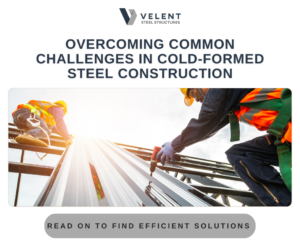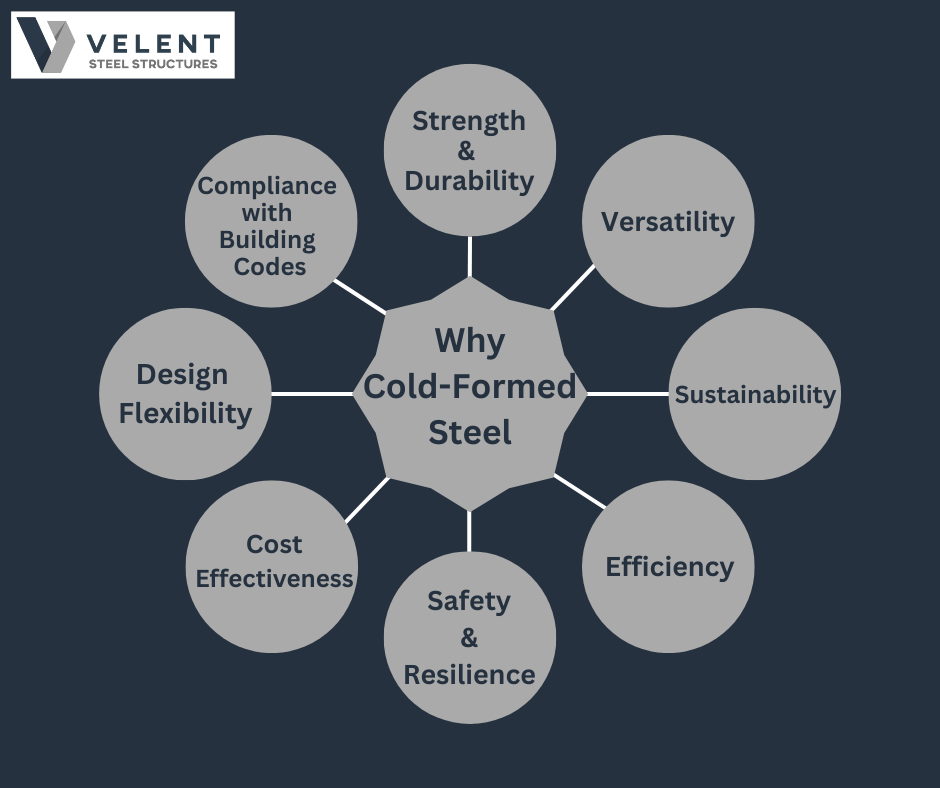The construction industry constantly evolves to adopt materials that offer superior performance, durability, and cost efficiency. Cold-Formed Steel (CFS) has emerged as a leading choice due to its lightweight, high strength, and flexibility. However, as with any construction material, working with CFS presents certain challenges that can affect project timelines, budgets, and overall success. Addressing these hurdles effectively can help developers, architects, and builders maximize the benefits of CFS, ensuring streamlined operations and high-quality results.

In this blog, we will explore the most common challenges faced in cold-formed steel construction and provide practical solutions to overcome them.
1. Design Complexity and Detailing
Challenge: Cold-formed steel construction requires intricate detailing and precise design calculations. Due to the thin-walled nature of the material, slight errors in design can lead to buckling, warping, or structural instability.
Solution: Collaborate with experienced structural engineers and leverage specialized design software such as Tekla Structures, FRAMECAD, or SteelSmart System. These tools facilitate accurate modeling and analysis, allowing engineers to predict potential weaknesses and adjust designs accordingly. Early involvement of design professionals ensures comprehensive planning, reducing errors during fabrication and installation.
2. Material Sourcing and Quality Control
Challenge: Variability in the quality of cold-formed steel can lead to inconsistencies in structural integrity and performance. Sourcing substandard materials may compromise the durability and longevity of the project.
Solution: Partner with reputable suppliers who adhere to industry standards, such as ASTM(American Society for Testing and Materials) A1003/A1003M. Conduct rigorous quality checks upon delivery and ensure that materials meet project specifications. Establishing a reliable supply chain helps mitigate risks associated with inferior products and guarantees consistent material performance.
3. Construction and Assembly Errors
Challenge: Due to the lightweight nature of CFS, misalignment during assembly can occur, affecting the overall structural integrity. Small miscalculations during fabrication or installation can lead to costly rework.
Solution: Implement a strict quality assurance (QA) program that involves regular inspections at each stage of the construction process. Utilize laser leveling and automated measuring tools to ensure precise alignment. Prefabrication of steel components off-site can also reduce on-site errors and streamline assembly.
4. Thermal Bridging
Challenge: Cold-formed steel has high thermal conductivity, which can result in significant heat loss and thermal bridging. This can lead to increased energy costs and compromised building efficiency.
Solution: Incorporate thermal breaks, such as insulated sheathing or continuous insulation, to mitigate heat transfer. Utilize advanced building wraps and vapor barriers to enhance the thermal performance of the structure. Additionally, consider hybrid solutions by integrating CFS with other materials that possess superior insulating properties.
5. Corrosion and Moisture Control
Challenge: Exposure to moisture can accelerate corrosion in cold-formed steel, potentially reducing its lifespan and compromising structural integrity.
Solution: Apply galvanized or zinc coatings to the steel components to enhance corrosion resistance. Ensure proper drainage and ventilation in building designs to minimize moisture buildup. Regularly inspect and maintain protective coatings, and choose CFS materials that comply with corrosion-resistant standards such as ASTM A653.
6. Acoustic Performance
Challenge: Steel is known for its low mass, which can result in poor sound insulation, causing noise transfer between rooms and floors.
Solution: Integrate acoustic insulation materials, such as resilient channels, sound-dampening drywall, and mineral wool batts, within the steel framing. Sealing all gaps and using staggered stud walls can further enhance acoustic performance, creating quieter, more comfortable living and working environments.
7. Fire Protection
Challenge: Although cold-formed steel is non-combustible, it can lose its strength at high temperatures, posing a risk during prolonged exposure to fire.
Solution: Incorporate fire-resistant cladding, gypsum boards, and intumescent coatings to enhance fire protection. Adhere to fire safety codes and regulations, ensuring that the building design includes adequate escape routes, fire barriers, and suppression systems. By addressing fire safety proactively, developers can enhance the resilience of steel structures.
8. Skilled Labor Shortage
Challenge: CFS construction often requires specialized skills that may not be readily available in all regions. This shortage of experienced labor can lead to delays and increased costs.
Solution: Invest in training programs for existing construction crews to upskill them in cold-formed steel techniques. Partner with professional CFS contractors who bring the necessary expertise to the project. Prefabrication of components can also reduce the need for specialized labor on-site, simplifying the construction process.
9. Integration with Other Building Systems
Challenge: Integrating cold-formed steel frames with other building materials and systems (e.g., concrete, wood, and HVAC) can pose compatibility issues.
Solution: Adopt Building Information Modeling (BIM) to facilitate seamless coordination between different trades and materials. BIM enables real-time collaboration, reducing clashes and ensuring smooth integration of structural, mechanical, and electrical systems. Engaging in early-stage planning helps avoid costly adjustments later in the project.
10. Cost Management
Challenge: While CFS is cost-effective in the long run, initial material and prefabrication costs can be higher than traditional materials, potentially impacting budget constraints.
Solution: Conduct a thorough cost-benefit analysis to highlight the long-term savings achieved through reduced labor, faster build times, and lower maintenance costs. Opt for prefabrication to minimize waste and labor costs. Negotiate bulk material purchases to secure better pricing and streamline logistics.
Conclusion
Cold-formed steel construction offers unparalleled advantages in terms of strength, flexibility, and sustainability. By addressing and overcoming the challenges associated with CFS, developers and builders can unlock its full potential, driving efficiency and ensuring project success. Embracing innovative solutions, investing in training, and leveraging technology will pave the way for more resilient and cost-effective steel structures in the future.
At Velent, we specialize in providing cutting-edge cold-formed steel solutions tailored to meet the evolving needs of the construction industry. Contact us today to discover how we can help you overcome challenges and achieve exceptional results with your next project.


